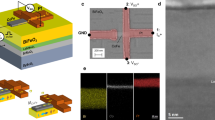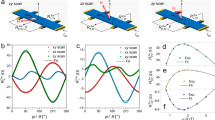Abstract
The magnetization direction of a metallic magnet has generally been controlled by a magnetic field or by spin-current injection into nanosized magnetic cells1,2. Both these methods use an electric current to control the magnetization direction; therefore, they are energy consuming. Magnetization control using an electric field3 is considered desirable because of its expected ultra-low power consumption and coherent behaviour. Previous experimental approaches towards achieving voltage control of magnetization switching have used single ferromagnetic layers with and without piezoelectric materials, ferromagnetic semiconductors, multiferroic materials, and their hybrid systems4,5,6,7,8,9,10,11,12,13,14,15. However, the coherent control of magnetization using voltage signals has not thus far been realized. Also, bistable magnetization switching (which is essential in information storage) possesses intrinsic difficulties because an electric field does not break time-reversal symmetry. Here, we demonstrate a coherent precessional magnetization switching using electric field pulses in nanoscale magnetic cells with a few atomic FeCo (001) epitaxial layers adjacent to a MgO barrier. Furthermore, we demonstrate the realization of bistable toggle switching using the coherent precessions. The estimated power consumption for single switching in the ideal equivalent switching circuit can be of the order of 104kBT, suggesting a reduction factor of 1/500 when compared with that of the spin-current-injection switching process.
This is a preview of subscription content, access via your institution
Access options
Subscribe to this journal
Receive 12 print issues and online access
$259.00 per year
only $21.58 per issue
Buy this article
- Purchase on Springer Link
- Instant access to full article PDF
Prices may be subject to local taxes which are calculated during checkout




Similar content being viewed by others
References
Berger, L. Emission of spin waves by a magnetic multilayer traversed by a current. Phys. Rev. B 54, 9353–9358 (1996).
Slonczewski, J. C. Current-driven excitation of magnetic multilayers. J. Magn. Magn. Mater. 159, L1–L7 (1996).
Curie, P. Sur la symétrie dans les phénoménes physiques, symétrie d’un champ électrique et d’un champ magnétique. J. Phys. 3, 393–415 (1894).
Nie, X. & Blügel, S. Elektrisches Feld zur Ummagnetisierung eines dünnen Films. European patent 19841034.4 (2000).
Weisheit, M. et al. Electric field-induced modification of magnetism in thin-film ferromagnets. Science 315, 349–351 (2007).
Maruyama, T. et al. Large voltage-induced magnetic anisotropy change in a few atomic layers of iron. Nature Nanotech. 4, 158–161 (2009).
Gamble, S. J. et al. Electric field induced magnetic anisotropy in a ferromagnet. Phys. Rev. Lett. 102, 217201 (2009).
Gerhard, L. et al. Magnetoelectric coupling at metal surfaces. Nature Nanotech. 5, 792–797 (2010).
Novosad, V. et al. Novel magnetostrictive memory device. J. Appl. Phys. 87, 6400–6402 (2000).
Lee, J-W., Shin, S-C. & Kim, S-K. Spin engineering of CoPd alloy films via the inverse piezoelectric effect. Appl. Phys. Lett. 82, 2458–2460 (2003).
Ohno, H. et al. Electric-field control of ferromagnetism. Nature 408, 944–946 (2000).
Chiba, D., Yamanouchi, M., Matsukura, F. & Ohno, H. Electrical manipulation of magnetization reversal in a ferromagnetic semiconductor. Science 301, 943–945 (2003).
Chiba, D. et al. Magnetization vector manipulation by electric fields. Nature 455, 515–518 (2008).
Eerenstein, W., Mathur, N. D. & Scott, J. F. Multiferroic and magnetoelectric materials. Nature 442, 759–765 (2006).
Chu, Y-H. et al. Electric-field control of local ferromagnetism using a magnetoelectric multiferroic. Nature Mater. 7, 478–482 (2008).
Shiota, Y. et al. Voltage-assisted magnetization switching in ultrathin Fe80Co20 alloy layers. Appl. Phys. Express 2, 063001 (2009).
Endo, M., Kanai, S., Ikeda, S., Matsukura, F. & Ohno, H. Electric-field effects on thickness dependent magnetic anisotropy of sputtered MgO/Co40Fe40B20/Ta structures. Appl. Phys. Lett. 96, 212503 (2010).
Duan, C-G. et al. Surface magnetoelectric effect in ferromagnetic metal films. Phys. Rev. Lett. 101, 137201 (2008).
Nakamura, K. et al. Giant modification of the magnetocrystalline anisotropy in transition-metal monolayers by an external electric field. Phys. Rev. Lett. 102, 187201 (2009).
Tsujikawa, M. & Oda, T. Finite electric field effects in the large perpendicular magnetic anisotropy surface Pt/Fe/Pt(001): A first-principles study. Phys. Rev. Lett. 102, 247203 (2009).
Nozaki, T., Shiota, Y., Shiraishi, M., Shinjo, T. & Suzuki, Y. Voltage-induced perpendicular magnetic anisotropy change in magnetic tunnel junctions. Appl. Phys. Lett. 96, 022506 (2010).
Shiota, Y. et al. Quantitative evaluation of voltage-induced magnetic anisotropy change by magnetoresistance measurement. Appl. Phys. Express 4, 043005 (2011).
Yuasa, S., Nagahama, T., Fukushima, A., Suzuki, Y. & Ando, K. Giant room-temperature magnetoresistance in single-crystal Fe/MgO/Fe magnetic tunnel junctions. Nature Mater. 3, 868–871 (2004).
Parkin, S. S. P. et al. Giant tunnelling magnetoresistance at room temperature with MgO(100) tunnel barriers. Nature Mater. 3, 862–867 (2004).
Chiba, D., Nakatani, Y., Matsukura, F. & Ohno, H. Simulation of magnetization switching by electric-field manipulation of magnetic anisotropy. Appl. Phys. Lett. 96, 192506 (2010).
Akimoto, H., Kanai, H., Uehara, Y., Ishizuka, T. & Kameyama, S. Analysis of thermal magnetic noise in spin-valve GMR heads by using micromagnetic simulation. J. Appl. Phys. 97, 10N705 (2005).
Acknowledgements
We would like to thank H. Tomita for his help with the simulations as well as S. Miwa for useful discussions. Y. Shiota thanks the Japan Society for the Promotion of Science for the fellowship. Part of this research was conducted under the financial support of the Global Center of Excellence (G-COE) program of the Ministry of Education, Culture, Sports, Science and Technology, Japan (MEXT).
Author information
Authors and Affiliations
Contributions
Y. Suzuki conceived and designed the experiments. Y. Shiota performed the experiments, simulations, and analysis. T.N. and Y. Suzuki led experiments and physical discussions. F.B., S.M., and T.S. contributed to the general discussions. Y. Shiota wrote the paper with reviews and inputs from Y. Suzuki and T.N.
Corresponding author
Ethics declarations
Competing interests
The authors declare no competing financial interests.
Supplementary information
Supplementary Information
Supplementary Information (PDF 686 kb)
Rights and permissions
About this article
Cite this article
Shiota, Y., Nozaki, T., Bonell, F. et al. Induction of coherent magnetization switching in a few atomic layers of FeCo using voltage pulses. Nature Mater 11, 39–43 (2012). https://doi.org/10.1038/nmat3172
Received:
Accepted:
Published:
Issue Date:
DOI: https://doi.org/10.1038/nmat3172
This article is cited by
-
Two-dimensional magnetic materials for spintronic applications
Nano Research (2024)
-
Deterministic field-free voltage-induced magnetization switching with self-regulated precession for low-power memory
Scientific Reports (2023)
-
Electrically programmable magnetic coupling in an Ising network exploiting solid-state ionic gating
Nature Communications (2023)
-
Voltage-controlled magnetic anisotropy in MgO/PtMnAs heterostructures
Applied Physics A (2023)
-
Spintronics intelligent devices
Science China Physics, Mechanics & Astronomy (2023)



